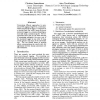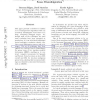ACL
1997
14 years 26 days ago
1997
String transformation systems have been introduced in (Brill, 1995) and have several applications in natural language processing. In this work we consider the computational proble...
ACL
1997
14 years 26 days ago
1997
In this paper, we describe a method for automatically retrieving collocations from large text corpora. This method retrieve collocations in the following stages: 1) extracting str...
ACL
1997
14 years 26 days ago
1997
Concerning different approaches to automatic PoS tagging: EngCG-2, a constraintbased morphological tagger, is compared in a double-blind test with a state-of-the-art statistical t...
ACL
1997
14 years 26 days ago
1997
We describe a simple variant of the interpolated Markov model with nonemitting state transitions and prove that it is strictly more powerful than any Markov model. More importantl...
ACL
1997
14 years 26 days ago
1997
This paper presents a method to combine a set of unsupervised algorithms that can accurately disambiguate word senses in a large, completely untagged corpus. Although most of the ...
ACL
1997
14 years 26 days ago
1997
Several recent efforts in statistical natural language understanding (NLU) have focused on generating clumps of English words from semantic meaning concepts (Miller et al., 1995; ...
ACL
1997
14 years 26 days ago
1997
ACL
1997
14 years 26 days ago
1997
This paper presents a trainable rule-based algorithm for performing word segmentation. The algorithm provides a simple, language-independent alternative to large-scale lexicai-bas...
ACL
1997
14 years 26 days ago
1997
This paper describes an approach to extract the aspectual information of Japanese verb phrases from a monolingual corpus. We classify Verbs into six categories by means of the asp...
ACL
1997
14 years 26 days ago
1997
In this paper we describe an approach to constraint based syntactic theories in terms of finite tree automata. The solutions to constraints expressed in weak monadic second order ...


